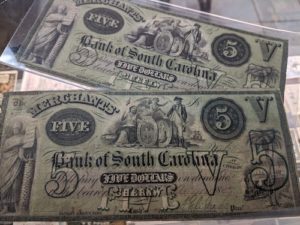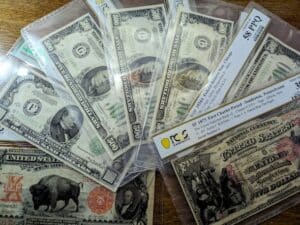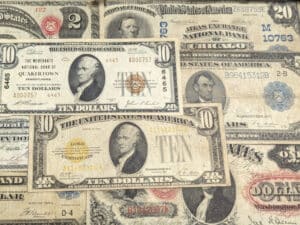Sell Your U.S. Paper Currency to Oakton Coins & Collectibles
Oakton Coins & Collectibles is always interested in buying your US paper currency collection. We regularly buy all types and conditions of US paper currency. From a single item to a full, comprehensive collection, we want to buy them. You will find us to be knowledgeable, attentive, respectful, and willing to pay the fair market value or more for your US paper currency.
Oakton Coins & Collectibles buys ungraded, certified, large, and small US paper money of all types and grades including: US Gold and Silver Certificates, National Currency notes, Treasury Notes, Confederate Banknotes, Fractional Currency, Continental Currency, Colonial Currency, and Broken Banknotes (Obsolete Notes).
Free Paper Money Grading With the Appraisal of Your Currency Collection
We provide free appraisals and free paper currency grading for all US currency we inspect for potential purchase.
Establishing a value for your paper money requires utilizing a number of information sources. Oakton Coins & Collectibles utilizes the Certified Currency Dealer Newsletter, otherwise known as the Green Sheet, as well as recent auction sales and other information sources, like population reports, to price your notes.
We buy paper currency collections graded by CGA, CGC, PMG, and PCGS Currency, as well as “raw” or non-graded collections. We can also submit your notes for grading, whether for your own collection or as a preface to buying your paper money. This helps guarantee you the highest price possible for your U.S. currency.
Grading Services
Currency Grading Authentication, PCGS Banknote, Legacy Currency Grading, Paper Money Grading (PMG)
Oakton Coins & Collectibles Buys U.S. Paper Currency of All Types
Also known as legal tender notes, United States Notes were issued in denominations of $1, $2, $5, $10, $20, $50, $100, $500 and $1000. The interesting and often intricate designs of large size Legal Tender Notes have collectors, and several notes have been given interesting nicknames such as:
- “Rainbow” ($10 Legal Tender – Series 1869)
- “Bison” ($10 Legal Tender – Series 1901)
- “Woodchopper” ($5 Legal Tender – Series 1907)
- “Sawhorse Back” ($1 Legal Tender – Series 1917)
- Fractional Currency 1862-1876
- National Bank Notes 1863-1938
- Gold Certificates 1878-1965
- Silver Certificates 1878-1965
- Treasury Notes 1890-1899
- Federal Reserve Notes 1914-Present
- Federal Reserve Bank Notes 1915-1945
- Large Size US Notes
- Colonial Currency
- Obsolete Notes (issued by private banks in the 1880’s)
- Confederate States of America notes
- Small Size US Notes
- Error Notes
Visit Oakton Coins & Collectibles for a free, no-obligation evaluation and offer on your US paper currency collection! Our expert buyers can provide a fair, accurate assessment of your paper money collection.
Paper Currency Grading Standards
Good: A heavily circulated note with obvious signs of handling. May include soiling and considerable wear and tear. Corners of the note may also be missing.
Very Good: An obviously well-circulated banknote with many creases and noticeable folds and wrinkles. Note may be dirty, “limp,” and dark in appearance. Corners may show severe wear and rounding, and some tears may be present. Note should be complete however, with no pieces missing.
Fine: Note has been considerably circulated and may have creases, folds, and visible wrinkles. Edges show evidence of circulation, and it may have slight tears. It may have very minor loss of color or extremely light stains.
Very Fine: A circulated note that still shows some signs of crispness. May have several vertical and horizontal folds as well as slight dirt or smudging visible. Will show signs of handling, though a VF note will have no tears on the edges.
Extra Fine: Paper is clean and bright with only faint evidence of circulation or handling. Bill may have several minor folds or one strong crease visible. No tears or discolorations.
About Uncirculated: A note that may initially appear as uncirculated, but closer examination discloses the slightest signs of handling: some minor corner folds, a light bend, a minor crease, or a slight finger smudge. Paper is still crisp and bright and has original sheen.
Crisp Uncirculated: A note that has not been released into circulation and still has its original crispness. Basically, the note is in the same condition as when it was first produced. The paper must be firm and crisp, without any creases, folds, or tears, and the corners must be sharp and square.
Paper Currency Star Notes
Star notes are used by the BEP (Bureau of Engraving and Printing) to replace misprinted/damaged currency before it goes into circulation. These replacement notes are printed just like normal notes, except there is a star printed in the serial number. On Federal Reserve Notes, the star is where the block letter normally is (the last letter of the serial number). On Legal Tender notes and Silver Certificates, the star is where the prefix normally is (the first letter of the serial number).



